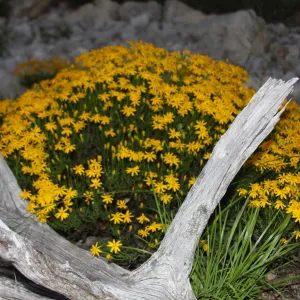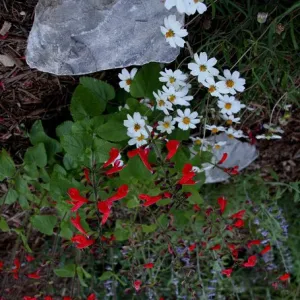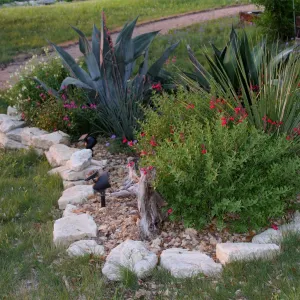by Carolyn Walden – Boerne Chapter, Native Plant Society of Texas
Published in Boerne Star on March 19, 2015
Let me introduce you to five of my favorite drought-tolerant plants, and provide a brief description and some of the added benefits of the plant, as promised in the Chapter 1 article published March 13, 2015. Five more will follow in Chapter 3. If you missed Chapter 1 here is how you can get specific information and pictures about the plants on the Native Plant Society (NPSOT) Boerne Chapter website http://www.npsot.org/wp/boerne/. Check out the Plant of the Month tab for 13 years of posters of flowers, shrubs, vines, trees and grasses that have been NICE! ™ (Natives Instead of Common Exotics) program featured plants. Click on a year to view the poster, which provides pictures and links to planting and care instructions for each of the featured plants. Also check out the Publications tab where you will find links to the NPSOT Monthly Newsletters, which include an article and pictures (in PDF version only) for that month’s featured plant and articles on gardening for butterflies and hummingbirds. The website also contains Recommended Native Plants for Boerne & Surrounding Counties (see the right sidebar on the Homepage for the links). Each of the plants below has been on a NICE! ™ poster; the month and year are at the end of each description.

Damianita (Chrysactinia mexicana), a 1-2 ft. tall and wide, evergreen shrub, is one of the most drought tolerant plants you can have, but you can love it to death by being too attentive (personal experience). Plant it in full sun; it will get leggy in shade and with too much water. It forms a rounded mound that has tiny dark green leaves that are very fragrant when touched. Damianita has small, fragrant, bright yellow, daisy-like flowers mostly in spring then occasionally after rains into summer and early fall. Deer generally will not bother this plant and rabbits don’t like the resinous leaves either! Plant a mass of this heat, freeze (to 0oF) and drought tolerant small shrub for dramatic springtime show on sun exposed hillsides, in rock or cactus gardens, or next to buildings or walls where reflected, hot sunlight keeps other things from growing. February 2012

Blackfoot Daisy (Melampodium leucanthum) is a 6-12” tall, full-sun loving perennial with small white daisy-like flowers that blooms from spring to fall. The flowers have a honey-scented fragrance. It grows in well-drained sand, caliche, limestone, and rocky gravelly soils and is very drought tolerant. Overwatering will kill this extremely drought tolerant plant, so don’t plant it in an area with sprinkler irrigation. Remove dead blooms to encourage more flowers. Cut back by half before spring to encourage compact fullness. In mild winters it can be evergreen and will be almost evergreen or dormant in colder winters. It provides nectar for bees, butterflies and insects and seed for birds; and is reportedly deer resistant. Blackfoot daisy is good for rock gardens and pairs well with damianita, Copper Canyon daisy, and prairie verbena or massed by itself. Use this NICE! little perennial instead of hybrid coreopsis or annuals such as zinnias, petunias and exotic perennials. March 2012
Monterrey White Oak (Quercus polymorpha), is a medium-sized shade, late deciduous to nearly evergreen tree that is resistant to Oak Wilt (a real plus). It grows moderately fast in most well-drained soils, depending on location and conditions. This oak grows best in full sun, but will tolerate partial shade. This is an excellent landscape tree, with a similar appearance, to replace Escarpment Live Oak without the high susceptibility to oak wilt, which is becoming a real problem throughout the Hill Country. January 2011

Salvias: Autumn Sage (Salvia gregii), Tropical Sage (Salvia coccinea), Mealy Sage (Salvia farinacea)
These three are only a few of native salvias that are drought tolerant. Autumn and tropical are mostly evergreen 1-3 foot tall shrubs that grow in sun to part shade and in almost any type of soil including caliche, sand, sandy loam, clay loam or clay. Mealy is a 2-3 foot tall perennial. Autumn and mealy need well drained soil, while tropical can tolerate poor drainage. Mealy does best on thin limestone soils, in full sun. Tropical sage will tolerate shade. All bloom spring to frost, especially if dead headed or lightly trimmed during the blooming season. Autumn varieties found at nurseries can come in white & in various shades of red; tropical can be red or white; and mealy can be white to bright blue or bright purple. Autumn sage flowers best in full sun. Tropical and mealy sage may reseed easily and both transplant well. Young tender growth on autumn sage may be browsed by deer. Deer do not eat tropical and mealy sage, at least in my experience. All of these plants are used by pollinator bees, butterflies and hummingbirds. Autumn and Tropical October 2010 Mealy May 2008.
Woolly Butterflybush (Buddleja marrubiifolia) is a medium-sized (3-6 feet), drought-resistant shrub that provides attractive foliage as well as colorful flowers throughout summer and into fall. It maintains its naturally dense form with little pruning. It is deciduous to almost evergreen with fine woolly hairs, thus the name, giving the plant a soft gray-green color and velvety feel. During summer through late fall, woolly butterflybush puts on a display of ½ inch round heads of small, bright yellow to orange flowers, which contrast nicely with the foliage, and attract butterflies as well as other nectar-feeding insects. Reportedly, and in my experience, the deer do not browse this plant, but some people have reported some damage. Used in a landscape, this shrub will add variety and texture as well as color to the design. April 2014
I think you will enjoy these plants. Stay tuned for Chapter 3 when I will introduce you to 5 more of my favorite drought tolerant plants.
